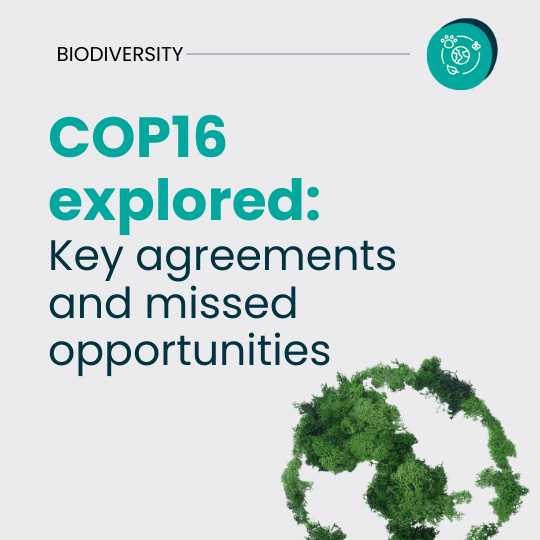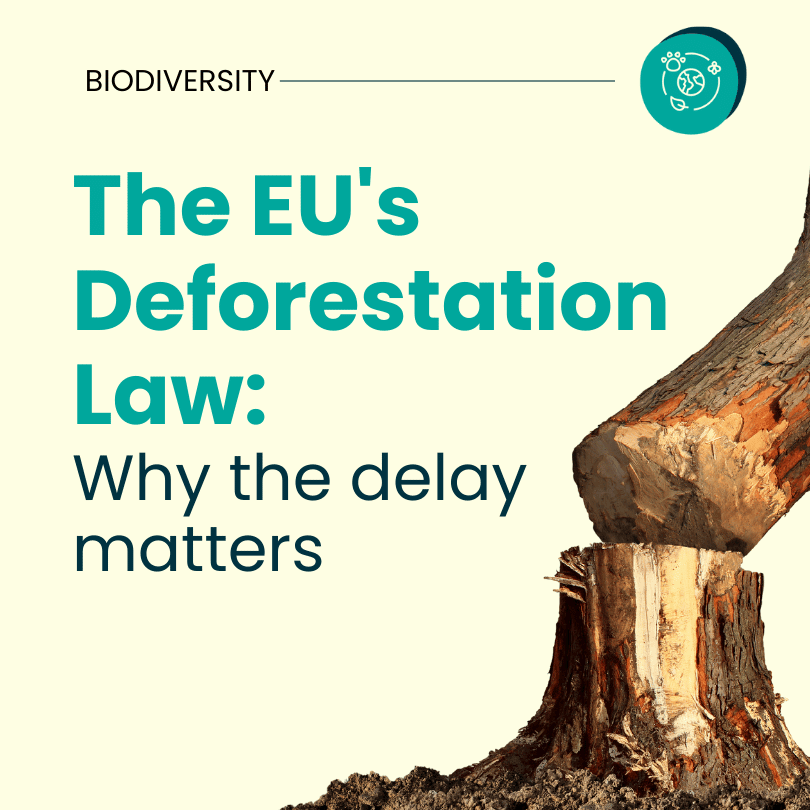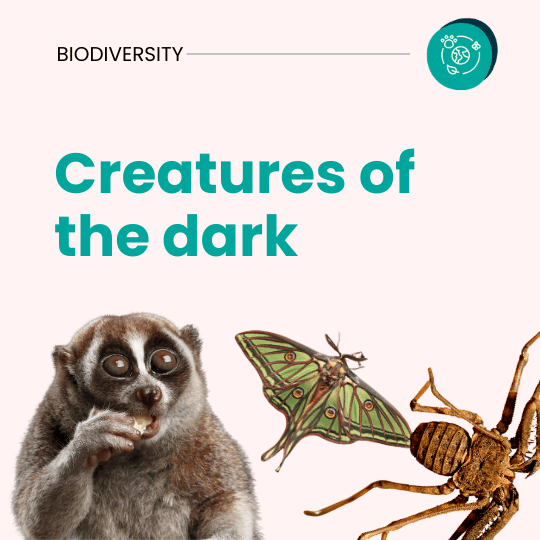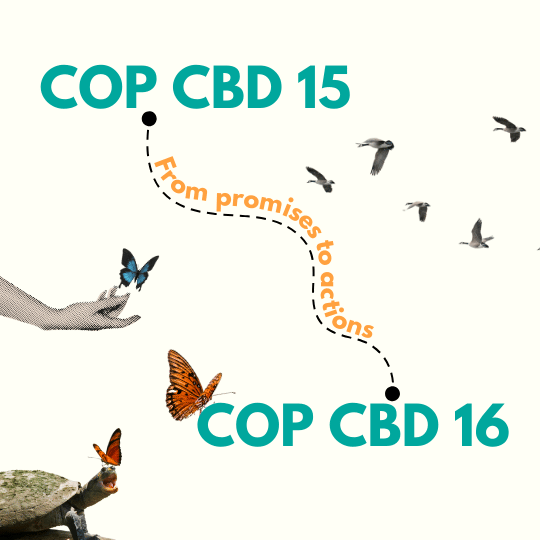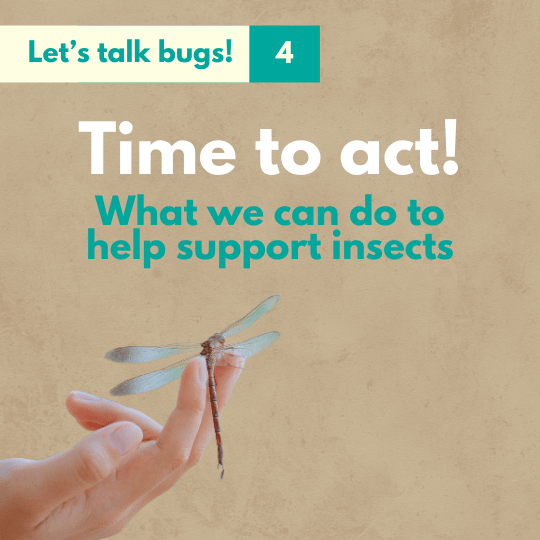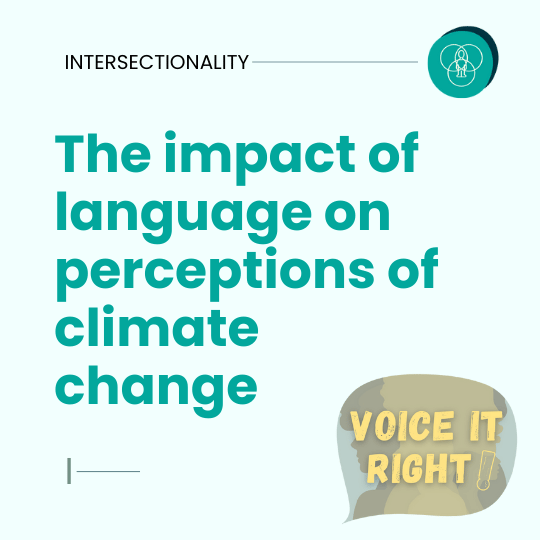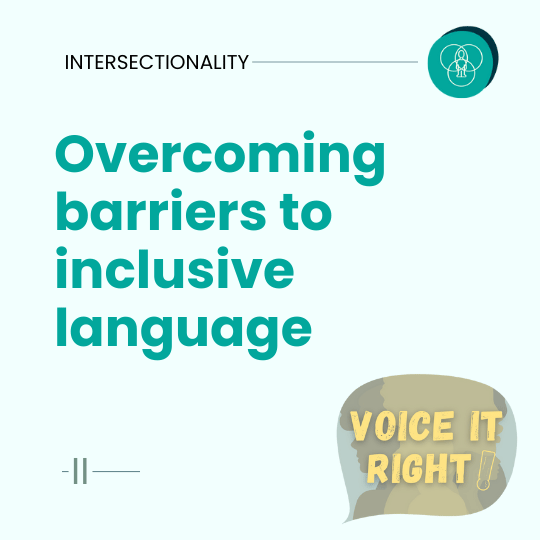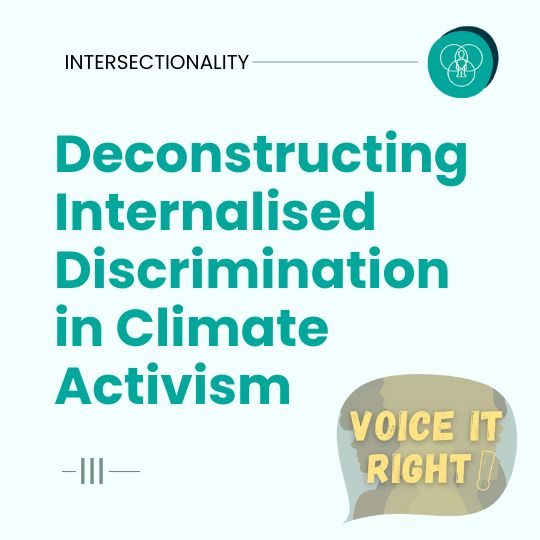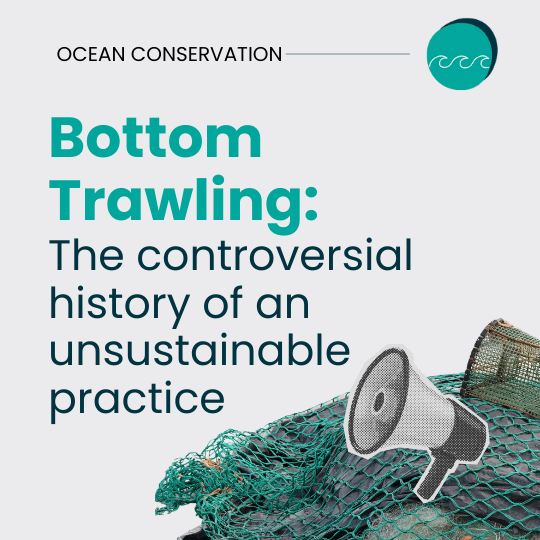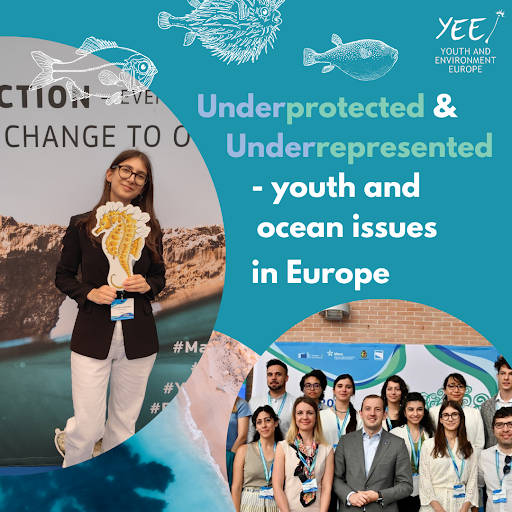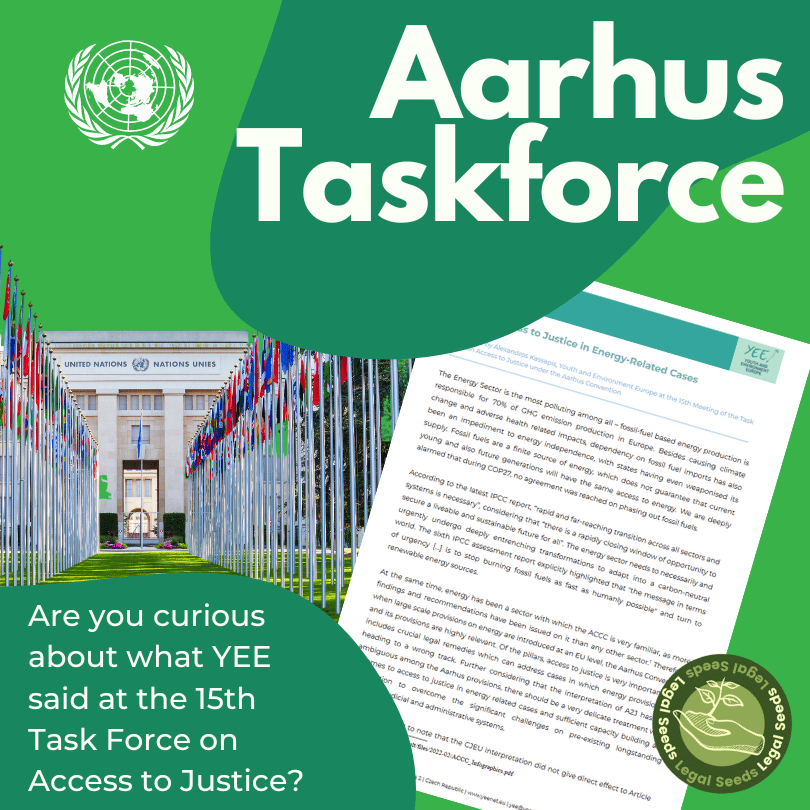COP16 Results Explored:
Key Agreements and Missed Opportunities
- November 28, 2024

Written by

Ashton Melfor

Emilie Tamo Kamguia
Contents
Share this article
The conclusion of the 16th meeting of the Conference of Parties to the Convention on Biological Diversity (CBD COP16) marks a pivotal moment in the global effort to address biodiversity loss and safeguard the planet’s ecosystems. Building on the commitments made in previous conferences, this year’s outcomes sought to turn ambitious goals into actionable solutions.
Parties to the convention were set to negotiate on key issues for the future of biodiversity conservation, sustainable use, and equitable benefit-sharing. Securing funding for biodiversity was poised to be one of the most anticipated outcomes of this year’s COP. In addition, all eyes were set on countries’ National Biodiversity Strategies and Action Plans (NBSAP) submissions, as these documents are critical for assessing global progress toward halting biodiversity loss.
Let’s look at what COP16 delivered.
COP16 highlights
Indigenous people recognition
One of the largest successes of this 16th UN Biodiversity Conference is the historic adoption of a Program of Work and the establishment of a new permanent Subsidiary Body on Article (8)j to formally acknowledge the essential role of Indigenous peoples and local communities in biodiversity conservation efforts. This new body will serve as a platform to collaborate with Parties and other organisations, enabling the application and promotion of their traditional knowledge, innovations, and practices regarding biological diversity.
Additionally, addressing historical exclusions, an agreement was reached to recognise the contribution of Afro-descendant communities, rooted in traditional lifestyles, in implementing the Convention and supporting biodiversity conservation and sustainable use.
After more than three decades of persistent advocacy, these decisions marked a significant milestone for better inclusion and justice in decision-making, as it is the first time a UN environmental agreement has taken such a step.
Financial resource mobilisation
Though parties agreed at COP15 to secure $200 billion annually by 2030 from all sources to support biodiversity initiatives worldwide, COP16 ended without much progress on this end. Unfortunately, only $163 million in new contributions were added to the already limited resources of the Global Biodiversity Framework (GBF) Fund.
The establishment of a new biodiversity fund was a major goal of this year’s COP presidency and developing countries. However, as COP16 drew to a close the dissatisfaction and distrust between countries became evident as no agreement was reached on this issue.
It is also concerning to see the prevalence of biodiversity credits at COP16. Despite the lacklustre results of carbon credits, some parties still push for further commodification of biodiversity. We must be very critical of these initiatives so as to not repeat the mistakes made with voluntary carbon credit markets and to mitigate the negative effects of neoliberal conservation policies.
Biodiversity credits must not detract from the commitments from governments to secure biodiversity financing.
Measuring progress
Of the CBD’s 196 Parties, the majority (119) submitted national biodiversity targets, policy measures and actions (NBSAPs) to reach the goals of the GBF. However, many countries have yet to submit their NBSAPs, which is the primary document that supports the implementation of the biodiversity targets. Accelerating action on this front is paramount to meet the GBF’s goal of halting biodiversity decline by 2030.
Need a reminder of what NBSAPs are?
Check out our article: The Road from COP CBD 15 to COP CBD 16
Negotiators reached an agreement (still to be adopted) on finer details related to the global review set to take place at COP17 and 19. This review aims to assess the progress made towards the main goal of the GBF based on NBSAPs and national targets. However, the agreement reached does not specify any action, besides reviewing their NBSAPs, that must be taken by countries after such a review.
Cali fund
This historic agreement actualises the agreement made at COP15 to develop a global mechanism to share the benefits of using Digital Sequence Information on genetic resources (DSI) fairly and equitably.
The Cali fund is designed to return some of the proceeds from the use of biodiversity back to protect and restore nature where these funds are needed most. It specifically targets large corporations and entities that derive commercial benefits from DSI. These enterprises are now bound to contribute a portion of the revenues derived from DSI to the Cali fund.
These resources will support the implementation of the Kunming-Montreal Global Biodiversity Framework (KMGBF), with developing countries benefiting from it the most.
Civil society engagement at COP
Branded “COP of the People” by the Colombian government, CBD COP 16 fostered citizen engagement with the creation of a “Green Zone”, a space open to all designed for hosting a large variety of activities including workshops, conferences and exhibitions. During the event, this platform welcomed about 700 000 visitors such as NGOs, business representatives, academics and local communities that were able to connect with peers, engage with other stakeholders, exchange knowledge and share their views on CBDs thematic issues. Youth participation was ensured with the presence of a dedicated Youth Pavilion, led by the Global Youth Biodiversity Network (GYBN), within the Green Zone.
However, the separation between this area and the “Blue zone”, room for formal negotiations of the Parties and dialogues with accredited observers, was criticised, as the public was left wishing for greater connection with policy-makers and interconnection between the two main zones.
Recognised as the largest CBD COP in number of participants, COP 16 nonetheless highlighted the need for strengthening the integration of civil society, including youth, in direct discussions with governments.
Conclusion
The outcomes of COP16 show both very encouraging progress and significant remaining challenges in addressing the biodiversity crisis.
With the Cali fund and the official recognition of Indigenous people and local communities, groundbreaking steps were made toward better inclusion and equity in biodiversity governance.
On the other hand, the incapacity of the Parties to reach an agreement on financial commitments and the limited accountability mechanisms signal the immense work still needed to meet the ambitious goals of the Global Biodiversity Framework. “Making Peace with Nature”, the theme chosen by this year’s host country, will require core decisions from Member States in the follow-up meetings that will be held to address unresolved issues.
As youth, we remain committed to intensifying our efforts to hold leaders accountable and ensure that promises translate into tangible actions.
More articles about biodiversity
COP16 Results Explored:
https://yeenet.eu/wp-content/uploads/2024/11/cop16.png 540 540 Eva Kloudová https://yeenet.eu/wp-content/uploads/2018/11/logo-yee-728x1030.png Eva Kloudová2024-11-28 14:41:342024-12-06 15:40:04COP16 Results Explored:The EU’s Deforestation Law: Why the delay matters
Despite the law’s importance in combating deforestation, the European Union recently announced a 12-month delay.
- November 15, 2024

Written by
Stavriana Neokleous
Contents
Share this article
Where do the products we consume in Europe really come from? Alarmingly, studies reveal that around 10% of EU consumption is linked to global deforestation, particularly in industries like palm oil and soy production. As we face the urgent threats of climate change and biodiversity loss, this issue cannot be ignored. In response, the European Union introduced the European Union Deforestation Regulation (EUDR), which came into force on June 29, 2023.
What is the EUDR?
This landmark regulation is a significant step toward reducing global deforestation. The EU is addressing its responsibility as a major contributor to deforestation through the consumption of products like cattle, wood, cocoa, soy, palm oil, coffee, rubber, and their derivatives such as leather, chocolate, tyres, and furniture.
The European Union Deforestation Regulation (EUDR) is a key component of the EU Green Deal, specifically supporting its environmental and climate goals by addressing deforestation linked to global supply chains.
The EUDR seeks to ensure that these products, traded and consumed within the EU and globally, no longer contribute to deforestation and forest degradation. Companies dealing in these products are now required to perform due diligence, ensuring that the goods they sell in, or export from the EU are not sourced from land deforested or degraded after December 31, 2020.
However, despite the law’s importance in combating deforestation, the European Union recently announced a 12-month delay in its full implementation, which has drawn significant criticism from civil society. Originally set to take effect on December 30, 2024, the delay responds to concerns raised by international trading partners and industries, particularly during the UN General Assembly in New York.
What led to the delay?
Pressure from international trade partners and industries, especially those in countries like Indonesia and Malaysia – which produce 85% of the world’s palm oil – argue that the regulation is discriminatory and disproportionately affects small-scale farmers. Many smallholders lack the resources to comply with the EU’s new due diligence requirements. Critics note that the EU barely consulted external stakeholders before adopting the EUDR.
Yet, there is strong support for the EUDR among small-scale farmers in countries like Ghana and Côte d’Ivoire. A coalition of over 120 civil society organizations and farmers’ groups representing more than 700,000 cocoa producers has backed the regulation. They see it as an opportunity to improve their livelihoods and promote sustainable supply chains. This support emphasises that, with adequate resources, small-scale farmers can meet the required standards, highlighting the importance of solidarity and EU assistance.
Why is the delay so serious?
Forests are vital carbon sinks, absorbing large amounts of CO₂ from the atmosphere. Current deforestation levels are dangerously high, threatening forests’ potential to act as carbon sinks. Every month of inaction allows for more forest destruction, worsening the climate crisis, accelerating the extinction of species dependent on these ecosystems, and violating Indigenous peoples’ rights.
For example, the Malaysian state of Sarawak is at high risk of being cleared for timber and oil palm plantations supplying international markets, with the EU being the third-largest destination for Malaysian palm oil exports.
The EUDR is essential not only to address environmental degradation but also to combat human rights and labor violations often associated with deforestation. The delay also disregards the efforts of companies and EU trading partners who have invested resources to comply with the EUDR on time. Many of these companies are striving to adopt sustainable practices, and the postponement undermines their initiatives. The delay also fails to protect vulnerable communities in the Global South who rely on threatened ecosystems for their livelihoods.
The EU’s global environmental commitments are also at stake. This isn’t the first time critical climate regulations have faced delays. The Fit for 55 climate package, aiming to reduce greenhouse gas emissions by 55% by 2030, and other key pieces of the European Green Deal have also encountered setbacks. Such delays raise doubts about the EU’s ability to achieve its long-term climate goals, threatening transparency and accountability.
What are the next steps?
The responsibility now lies with the European Parliament and the Council of Ministers to navigate international tensions and finalise the regulation’s implementation by 2025 through a formal vote. Further negotiations will likely involve compromises with trading partners and domestic industries, but it is crucial that the EUDR’s core environmental objectives remain intact.
There is also a crucial window of opportunity to support Least Developed Countries (LDCs) in the transition to sustainable supply chains. To prevent these countries from being left behind, the EU should increase financial and technical assistance, enabling LDCs to develop the necessary infrastructure and capacity to comply with the regulation, with a focus on supporting smallholder farmers. Most importantly, the EU must engage in continuous dialogue with LDC governments and stakeholders to address challenges and ensure a smooth, equitable transition.
What can you do?
Ensuring that the EUDR goes into full effect without further delay is essential to maintaining momentum in the fight against deforestation. As young citizens, we must ensure the EU remains committed to its environmental responsibilities. Here are some actions you can take:
- 〇 Contact your Members of the European Parliament (MEPs) and urge them to prioritise the swift implementation of the EUDR.
- 〇 Support environmental campaigns and create or sign petitions.
- 〇 Learn more about this issue
- 〇 Raise awareness about the importance of deforestation laws, sharing information with others to keep the pressure on decision-makers.
The time for action is now. Together, we can demand a future that protects both the environment and people.
More articles about biodiversity
The EU’s Deforestation Law: Why the delay matters
https://yeenet.eu/wp-content/uploads/2024/11/The-EUs-Deforestation-Law-featured-image.png 810 810 YEE https://yeenet.eu/wp-content/uploads/2018/11/logo-yee-728x1030.png YEE2024-11-15 13:57:472024-11-15 14:47:13The EU's Deforestation Law: Why the delay mattersCreatures of the dark
While nighttime activities are popular with humans for a few nights a year, some creatures keep it creepy all year round.
- October 31, 2024

Written by

Ashton Melfor
Contents

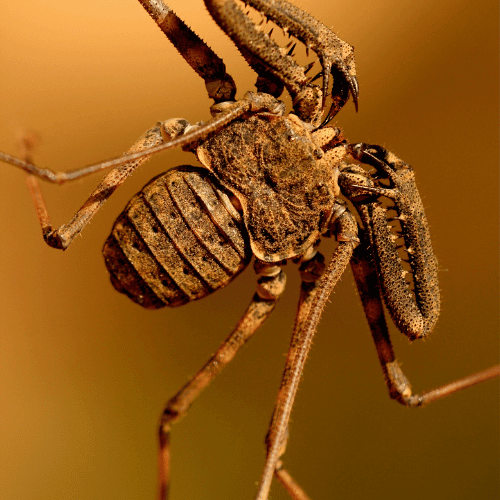
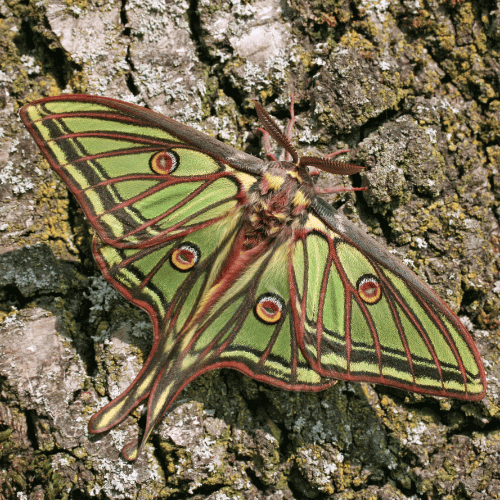



Share this article
For many people, Halloween is the one time of the year when being active at night is a must, whether to remember those who have passed or to celebrate the macabre and supernatural.
While nighttime activities like trick-or-treating, themed parties, and haunted house visits are popular with humans for a few nights a year, some creatures keep it creepy all year round.
Why choose to be active at night?
For years, scientists have studied the advantages of nocturnality. A recent study now suggests that activity in darkness provides a survival advantage. This research points to four key survival benefits that helped nocturnal creatures outlast their daytime counterparts, especially during mass extinctions.
Let’s meet a few of these eerie night dwellers!
Adorable but deadly
We’ll start with arguably the cutest animal on this list. The Loris. As the common name, Slow Loris, for the species in the genus Nycticebus suggests, these beady-eyed mammals are not the fastest. But don’t be fooled by their harmless appearance as Lorises are the only venomous primates on the planet.
These dwellers of the night are specially adapted to life in the dark. Having large eyes increases their ability to capture light, improving night vision. When threatened, lorises use their bare patch that secretes oil, mixing it with saliva to create venom. Despite being really slow, these animals are skilled hunters using their slow pace to sneak up on unsuspecting prey. Truly giving new meaning to the saying “silent but deadly”.
A true creepy crawler
Now we move to a true creepy crawler, the whip spider. Despite what the name may suggest, these are not true spiders. Unlike true spiders in the order Araneae, whip spiders belong to the order Amblypygi. (See our previous article on why neither are insects!)
Whip spiders are, like their namesake, predators, hunting all kinds of arthropods. But unlike spiders, they do not possess silk glands for making webs. For this reason, they have developed an active hunting strategy. Using their modified legs, they sense prey items, once found they sprint towards them and grab the prey item with their spikey pedipalps. Witnessing this in action is sure to create an unsettling feeling in anyone. Whip spiders are found primarily in tropical to subtropical climates. They prefer moist dark places coming out to hunt when most of us are asleep.
Endangered Beauty
For the third and final animal on our list, we stay in the realm of arthropods. Ever heard of the moon moth? Saturnia isabellae or Spanish moon moth is a moth in the large family called Saturniidae. Like most moths the Spanish moon moth flies during the night, searching for a partner or places to lay their eggs.
As the name suggests it is found in Spain, specifically the Pyrenees. What makes this species so special is that it lives in a relict population.
What is a relict (refuge) population?
A relict population is a remnant group of organisms that has survived in a restricted area after once being more widespread and diverse, often due to physical or climatic changes in its habitat.
During the last ice age, this species was more abundant, being well-adapted to the cold. However, as the climate changed it has been confined to all but the coldest parts of the Pyrenees. There its caterpillars feed on pine needles.
Having a restricted and fragmented range and with anthropogenic climate change further threatening its refuge habitat, means that this species is strictly protected under the EU Habitats directive.
So, this Halloween, when you’re out trick-or-treating or visiting a haunted house, remember at sundown all manner of mysterious creatures come alive. Keep your eyes peeled and who knows what you may come across.
More articles about biodiversity
Creatures of the dark
https://yeenet.eu/wp-content/uploads/2024/10/haloween-post.png 540 540 YEE https://yeenet.eu/wp-content/uploads/2018/11/logo-yee-728x1030.png YEE2024-10-31 08:14:042024-10-31 08:37:08Creatures of the dark
Climate activism has grown into a powerful global movement, uniting people from diverse backgrounds in the fight against environmental degradation. However, despite its inclusivity on the surface, the movement is not immune to deeper issues of internalised discrimination, particularly within its own ranks.
Internalised discrimination refers to the unconscious acceptance of the dominant culture’s prejudices and stereotypes by marginalised individuals, often leading to self-limiting beliefs and actions
In the context of climate activism, this can manifest as the perpetuation of environmental racism, the marginalisation of non-Western perspectives, and the reinforcement of Eurocentric ideologies that fail to account for the diverse experiences and knowledge systems of affected communities.
Internalised discrimination in climate activism can have several detrimental effects:
- 〇 It may lead to the exclusion of voices from the Global South, Indigenous communities, and other marginalised groups, whose experiences and traditional knowledge are crucial in crafting effective and just climate solutions.
- 〇 It can create a hierarchical structure within the movement that prioritises certain voices over others, often aligning with historical patterns of oppression and colonialism. This not only weakens the movement’s moral foundation but also undermines its effectiveness by disregarding comprehensive and culturally relevant solutions to climate challenges.
Key Issues
- Environmental Racism: Internalised discrimination often manifests through environmental racism, where the voices of marginalised communities, particularly those of colour, are sidelined or ignored in environmental advocacy. These communities are disproportionately affected by environmental hazards yet frequently excluded from decision-making processes. Addressing internalised discrimination requires acknowledging and actively countering this imbalance.
- Eurocentric Thinking: Climate activism, particularly in Western contexts, can be dominated by Eurocentric thinking that overlooks or undervalues the contributions and perspectives of non-Western cultures. This can lead to the imposition of solutions that are not suitable for all regions, particularly those in the Global South, where the impacts of climate change are most severe. Deconstructing this bias involves recognising the value of indigenous knowledge and practices, and integrating these into the global discourse on climate action.
- Bias and Representation: Activists from marginalised backgrounds may internalise negative stereotypes, leading to self-doubt or a belief that their perspectives are less valid. This can result in lower participation rates among these groups, reinforcing the dominance of more privileged voices. Combating this requires intentional strategies to uplift and empower underrepresented activists within the movement.
Strategies for Change
- Education and Awareness: Raising awareness about internalised discrimination and its impact on the movement is a crucial first step. Educational initiatives should focus on helping activists recognise and address their own biases, as well as those embedded in the movement’s structures.
- Inclusive Leadership: Promoting leadership roles for individuals from marginalised communities can help diversify perspectives and approaches within the movement. This can also provide role models for others, fostering a more inclusive environment.
- Cross-Cultural Collaboration: Encouraging partnerships between activists from different cultural backgrounds can help break down Eurocentric barriers and foster a more global perspective on climate action. These collaborations should be based on mutual respect and a recognition of the unique contributions each group brings to the table.
- Policy Advocacy: Advocating for policies that address environmental racism and promote equity in climate action is essential. This includes pushing for greater inclusion of marginalised communities in decision-making processes at all levels.
Deconstructing internalised discrimination within climate activism is essential for building a truly inclusive and effective movement. By addressing issues like environmental racism and Eurocentric thinking, and by promoting strategies for inclusive leadership and cross-cultural collaboration, we can ensure that the voices of all those affected by climate change are heard and valued. This not only strengthens the movement but also leads to more just and sustainable solutions to the global climate crisis.
More articles from the #VoiceItRight campaign
Deconstructing Internalised Discrimination in Climate Activism
https://yeenet.eu/wp-content/uploads/2024/10/voice-it-right.png 540 540 YEE https://yeenet.eu/wp-content/uploads/2018/11/logo-yee-728x1030.png YEE2024-10-10 14:28:532024-10-31 09:47:05Deconstructing Internalised Discrimination in Climate Activism
Written by

Ashton Melfor
Contents
Visual summary








Share this article
Looking back at COP 15
With the next conference of the parties to the convention on biological diversity (COP 16) right around the corner, let’s look back at what was achieved the last time around. The most important achievement of COP 15 was the adoption of the Kunming-Motreal Global Biodiversity Framework (GBF). After 4 years of negotiations, a post-2020 Global Biodiversity Framework was finally adopted. This new GBF follows a failure on behalf of the parties to achieve the targets set out in the previous decade. The new framework sets out 4 ambitious goals for halting biodiversity loss and the sustainable use of genetic resources. Transforming our relationship with nature and be nature positive by 2050.
Key Points of the GBF:
Goals for 2050: The framework sets out four long-term goals to achieve a vision of living in harmony with nature by 2050.
Targets for 2030: There are 23 specific targets to be achieved by 2030, focusing on conservation, sustainable use, and equitable sharing of benefits from biodiversity.
Global Vision: The overarching vision is to ensure that by 2050, biodiversity is valued, conserved, restored, and wisely used, maintaining ecosystem services, sustaining a healthy planet, and delivering benefits essential for all people.
To achieve these goals the framework sets out 23 targets. These global targets must be achieved by 2030. By far the most significant target is the so-called 30 by 30 which aims at restoring 30% of terrestrial and aquatic ecosystems by 2030. We discuss the outcomes of COP 15 and go more in depth on some of the targets in a previous article.
Broadly the targets can be divided into 3 key areas:
- Minimising risks to biodiversity.
- Addressing human needs through sustainable utilisation and equitable benefit-sharing.
- Strategies and solutions for implementation and integration.
What’s at stake COP 16
“A world living in harmony with nature by 2050”. That was the vision set forth by countries at COP 15. As the first COP being held after the adoption of the global biodiversity framework, COP 16 will serve as the first review moment for this framework. The parties to the convention are tasked with reviewing the protocol’s state of implementation, additionally, they must show that their National Biodiversity Strategies and Action Plans (NBSAPs – explained in the next section) are in alignment with the new targets and goals of the framework.
At COP 16, the parties will also enhance the monitoring framework and improve resource mobilisation for the Global Biodiversity Framework. Among other responsibilities, COP 16 is also expected to complete and implement the multilateral mechanism for the fair and equitable sharing of benefits derived from the use of digital sequence information on genetic resources.
What are National Biodiversity Strategies and Action Plans (NBSAPs)
National Biodiversity Strategies and Action Plans (NBSAPs) are essential tools for countries to plan how they will protect and use their biodiversity sustainably. According to Article 6 of the Convention on Biological Diversity, every country that is part of the convention must create these plans.
NBSAPs outline each country’s specific actions and strategies to meet the goals of the convention. They also show how these biodiversity plans are integrated into other national policies and sectors, ensuring a coordinated approach to biodiversity conservation.
So, NBSAPs will serve as the main tool for implementing the GBF at the national level, with parties monitoring and reviewing their progress towards achieving the GBF goals and targets through regular National Reports. These reports contribute to the Global Biodiversity Outlook, which periodically summarises the latest data on global biodiversity status and trends and analyses the global community’s efforts to conserve and sustainably use biodiversity. They are the keys to the goals to be achieved. Unlike the previous ones, goal D provides the technical and financial means necessary to achieve the other 3 goals.
Want to know what’s in your country’s NBSAPs including the European Biodiversity Strategy?
Take a look at the latest submissions.
Together, we can make a difference. Join us in sharing our vision for COP16 and ensure our voices are heard.
More articles about biodiversity
The Road from COP CBD 15 to COP CBD 16
https://yeenet.eu/wp-content/uploads/2024/09/COP-CBD-16.png 540 540 Eva Kloudová https://yeenet.eu/wp-content/uploads/2018/11/logo-yee-728x1030.png Eva Kloudová2024-09-30 16:53:172024-10-01 06:51:19The Road from COP CBD 15 to COP CBD 16
Written by
Stavriana Neokleous
Contents
Share this article
Sources
- Wardle, C. S. (1986). Fish behaviour and fishing gear. In The behaviour of teleost fishes (pp. 463-495). Boston, MA: Springer US.
- Steadman, D., Thomas, J. B., Villanueva, V. R., Lewis, F., Pauly, D., Palomares, M. L., … & Collinson, T. (2021). New perspectives on an old fishing practice: Scale, context and impacts of bottom trawling. Our Shared Seas, Report, 44.
De Groot, S. J. (1984). The impact of bottom trawling on benthic fauna of the North Sea. Ocean management, 9(3-4), 177-190.
Hiddink, J. G., Kaiser, M. J., Sciberras, M., McConnaughey, R. A., Mazor, T., Hilborn, R., … & Jennings, S. (2020). Selection of indicators for assessing and managing the impacts of bottom trawling on seabed habitats. Journal of Applied Ecology, 57(7), 1199-1209.
Parker, R. W., Blanchard, J. L., Gardner, C., Green, B. S., Hartmann, K., Tyedmers, P. H., & Watson, R. A. (2018). Fuel use and greenhouse gas emissions of world fisheries. Nature Climate Change, 8(4), 333-337.
Paradis, S., Goñi, M., Masqué, P., Durán, R., Arjona‐Camas, M., Palanques, A., & Puig, P. (2021). Persistence of biogeochemical alterations of deep‐sea sediments by bottom trawling. Geophysical Research Letters, 48(2), e2020GL091279.
Clark, M., & Tilman, D. (2017). Comparative analysis of environmental impacts of agricultural production systems, agricultural input efficiency, and food choice. Environmental Research Letters, 12(6), 064016.
European Parliament and the Council of the European Union. (2008). Directive 2008/56/EC of the European Parliament and of the Council of 17 June 2008 Establishing a Framework for Community Action in the Field of Marine Environmental Policy (Marine Strategy Framework Directive). Official Journal of the European Union, L 164, 19-40.
Scholaert, F. (2023). Action plan to protect marine ecosystems for sustainable fisheries. European Parliamentary Research Service.
What is Bottom Trawling?
Fisheries are an essential resource, supporting human well-being and sustaining the livelihoods of billions of people worldwide, especially in coastal communities. As a major economic sector, fisheries have profound socio-political and environmental impacts. Various fishing techniques are employed globally, each selected based on factors such as the target species, fish behaviour, location, and timing. Bottom trawling is a widespread fishing practice which accounts for approximately 26 per cent of the total fish catch within the Exclusive Economic Zones (EEZ) and on the high seas.
An exclusive economic zone, as prescribed by the 1982 United Nations Convention on the Law of the Sea, is an area of the sea in which a sovereign state has exclusive rights regarding the exploration and use of marine resources, including fishing.
This practice is especially prevalent in Europe, North America, and East Asia, where it is used to harvest a variety of marine species, including cod, shrimp and squid. Bottom trawling involves dragging a weighted net or a rigid frame along the ocean floor, a method that is often confused but is distinct from pelagic trawling, which targets fish in the water column.
Environmental impacts
Originating in the United Kingdom during the 1300s, bottom trawling underwent significant industrialization in the 20th century due to advancements in technology. Over time, various trawling gear, including beam trawls and otter trawls, have been developed to suit different environments and species, impacting the environment in diverse ways. Despite its economic advantages, bottom trawling is contentious due to its considerable environmental and ecological impacts. It is linked to several major threats to biodiversity, such as the overharvesting of target species, bycatch of non-target species, and the destruction of seabed habitats. Studies have shown that this method reduces marine species diversity and biomass, often favouring short-lived species, which disrupts the ecosystem’s food web and functioning. This disruption can lead to a decrease in prey availability for commercially important fish.
The practice of bottom trawling is also under scrutiny for its contribution to greenhouse gas emissions. Fisheries collectively use about 40 billion litres of fuel annually, generating approximately 179 million tonnes of CO2-equivalent emissions, which accounts for 4% of the global food production emissions. Among these, bottom trawling is particularly harmful, as it releases carbon dioxide stored in the seafloor into the atmosphere, contributing to global warming. Without bottom trawling, this carbon could be safely stored under the sea bed. Research from 2021 found that continuously trawled areas at depth of 500 metres has 30% less organic carbon in the sediment at similar depths where trawling was banned for just two months. This 30% reduction is significant, as it showcases how bottom trawling can drastically deplete organic carbon that would otherwise remain sequestered in marine sediments. Additionally, an older study indicated that bottom-trawl fisheries emit nearly three times more greenhouse gases compared to non-trawl fisheries, furtherly highlighting the serious impact on climate change.
Socio-economic impacts
The socio-economic effects of bottom trawling are varied and significant, though comprehensive formal documentation is limited. A recent report from Steadman and others highlights key areas of impact, including economic consequences, social conflicts, food security, harbour conditions, and health and safety. While bottom trawling can provide affordable fish, its economic impact is felt differently across various communities. It often depletes resources that small-scale fishers depend on, impacting food security for coastal communities. For example, in Southeast Asia small-scale fisheries support millions through direct consumption and aquaculture feed, benefiting lower-income populations. Beyond these economic and social consequences, bottom trawling has also been linked to human rights abuse, particularly in regions with weaker regulatory systems. Regional variations in socio-economic impacts are also evident. For example, Scotland’s Inshore Exclusion Zone (IEZ), established in 1889 to protect small-scale fishers by banning bottom trawling within three miles of the shore, was repealed in 1984. This change allowed bottom trawling to encroach on inshore waters, leading to the collapse of local fisheries, heightened conflicts, and the loss of traditional cultural practices.
Regulatory framework
In response to the significant environmental and socio-economic challenges posed by bottom trawling, Europe has developed a range of regulatory frameworks. The Marine Strategy Framework Directive (MSFD), introduced in 2008, has been a key legislative instrument aimed at protecting the marine environment across Europe, with a focus on achieving Good Environmental Status (GES) of marine waters . However, as environmental pressures have evolved, so too have the strategies to address them. The European Union has now placed increased emphasis on the Marine Action Plan (MAP), which is part of the broader European Green Deal and aims at making fishing practices more sustainable. This includes transitioning to more selective fishing gear, utilising technological innovations to reduce bycatch of sensitive species, and gradually phasing out mobile bottom trawling in all Marine Protected Areas (MPAs) by 2030 .
Call for collective action
While bottom trawling remains a vital part of the global fishing industry, its environmental and socio-economic impacts cannot be overlooked. Recent efforts in Europe, particularly through the latest Marine Action Plan, signal a shift towards more sustainable fishing practices. Greece and Sweden have taken a significant step by banning bottom trawling within all their National Parks and Marine Protected Areas (Greece) and the entirety of their territorial waters (Sweden), setting a positive example that more European countries might follow.
Many NGOs, such as Oceana and Seas at Risk, are at the forefront of efforts to phase out bottom trawling, including this campaign urging the EU to take stronger action against Member States that continue to allow bottom trawling in Marine Protected Areas. Similarly, the Transform Bottom Trawling Coalition is working to build a global movement aimed at restoring ocean health by eliminating destructive fisheries, while protecting the livelihoods of communities who depend on a sustainable ocean. Achieving these goals will require collective actions from all stakeholders – policymakers, industry and consumers – who must work together to phase out destructive practices and ensure sustainability of our oceans for future generations.
As we continue to explore these issues, a series of webinars will follow this article offering deeper insights and discussions on the future of bottom trawling. We invite you to join these sessions and contribute to shaping a more sustainable future for our oceans!
More on ocean-related issues
Bottom Trawling: The controversial history of an unsustainable practice
https://yeenet.eu/wp-content/uploads/2024/10/bottom-trawling.png 540 540 Eva Kloudová https://yeenet.eu/wp-content/uploads/2018/11/logo-yee-728x1030.png Eva Kloudová2024-09-17 16:22:182024-10-31 09:38:21Bottom Trawling: The controversial history of an unsustainable practice
Share this article
Written by

Martina Mussa
Contents
Sources:
- Language exclusion: the unheard face of the climate crisis
- COP28 and beyond: Five tips for gender-inclusive climate reporting
- Inclusive climate action in practice 3.0: Gender
- How Can Climate Action Be Inclusive?
- daily.jstor.org
- Compass – Manual for Human Rights Education with Young People; II Edition updated in 2020.
- Inclusion Toolbox – A guide on inclusive practices; European Youth Foundation, Council of Europe.
- The environmental movement is very white. These leaders want to change that.
- Paternalistic and ‘othering’ language in the charity sector
- Overcoming Language and Cultural Barriers: Promoting Inclusion in Multilingual and Multicultural Workplaces
- From Talk to Action: Rethinking the Language of Climate Change
- Language: a tool for activism and preserving peace
- How Can Climate Action Be Inclusive?
- Manual for the design of a training course on intercultural competence
- Inclusive language guide
Follow the #VoiceItRight campaign on
As we already mentioned, in the context of youth work and climate activism, language plays a pivotal role in shaping perceptions, influencing behaviour and reflecting values. Inclusive language ensures that climate activism is accessible and welcoming to all, regardless of background or identity.
This is crucial to avoid bias, stereotypes or expressions that discriminate against groups of people based on race, gender, socioeconomic status, disability or other factors.
Inclusive (intercultural) communication: is a transparent, truthful, accessible, and engaging communication that reflects the diversity of the society, promotes a climate of openness to intercultural encounters, and creates a shared sense of belonging.
Understanding barriers to inclusive language
If we want to foster inclusive language in our work for climate action it is important to recognise obstacles and barriers that can be hinder climate activism initiatives and inadvertently marginalise groups. In fact, many environmental terms were developed in context that did not prioritise inclusivity. For instance, the term “Developing countries” can be considered paternalistic.
Lack of diversity within environmental movements and youth organisations can lead to the exclusion of voices and perspectives that could otherwise share best practices and useful approaches to foster inclusivity.
By understanding and addressing these barriers we can foster communication that is equitable, accessible and truly representative of diverse perspectives. This awareness can help us to avoid language that can unintentionally exclude, alienate, or marginalise certain groups, perpetuating existing inequalities and limiting participation. A language that is inclusive and culturally sensitive serves as a tool for empowerment, fostering dialogue, and building inclusive movements that reflect the needs and contributions of all people.
Prevalence of technical language
The extensive use of jargon and technical language can make environmental issues seem inaccessible or irrelevant to those without a background in the field. In fact, too often scientists use the deceptively passive “neutral” language to explain climate change-related events to better reflect both scientific accuracy and the true gravity of the situation.
At the same time, the media tend to follow the scientists’ lead, by adopting the so-called “neutral” language in order to avoid alarming anyone with any uncomfortable emotions.
This has serious consequences, as it may limit the reach of activism’ initiatives. In fact, only people with certain knowledge on the topic or educational levels feel qualified to participate.
Cultural and linguistic differences
Environmental activism often originates in contexts where the dominant cultural norms shape the discourse, potentially excluding those from different cultural backgrounds who may have unique perspectives on environmental issues. A core example of this is the role of indigenous communities, who are often at the forefront of environmental stewardship and yet could find their voices marginalised if the language used does not reflect their experiences.
Western-centric approaches
Too often environmentalism has been shaped by and centred on western perspectives. This western-dominated approach typically emphases certain principles, practices and solutions that may not align with the environmental realities or cultural values of non-Western communities.
An example of this approach relies on the focus on conservation efforts like national parks or wildlife reserves, which are rooted in the idea of preserving “pristine” nature. Despite the good intentions behind these methods, they might hinder or even undermine the traditional ecological knowledge of indigenous and local communities who have been sustainably managing their environments for generations.
Another consistent difference is the tendency of framing environmental issues through a lens of individual responsibility. This includes reducing personal carbon footprints or adopting a sustainable lifestyle. Although these actions are important, they often do not consider structural inequalities that disproportionately affect non-Western and vulnerable groups. In fact, most communities in the Global South who contribute the least to global carbon emissions are the most affected by and suffer the most from the consequences of climate change. However, the dominant narrative may place undue emphasis on individual actions without addressing the larger, systemic forces driving environmental degradation.
Stereotypes
A certain use of language can perpetuate stereotypes and bias or fail to acknowledge systemic inequalities. This has the potential to alienate marginalised groups. For instance, framing environmental issues solely in terms of individual responsibility can overlook the disproportionate impact of environmental degradation on low-income and vulnerable communities, who may have less capacity to effect change through personal choices alone. As a consequence, feelings of exclusion or frustration can characterize those who feel that their struggles are not being adequately addressed.
How to ensure inclusive (intercultural) communication
According to the Council of Europe guidelines, we can distinguish three key components of inclusive communication.
- Accessibility for everyone
- Representativity of the population
- Narratives that favour openness to valuing diversity.
Accessibility
Everyone has access to – and ability to understand and feel targeted by – public communication and information that is needed to fully enjoy their rights. The words and images used, the communication channels, the language style and availability of the core information in several languages, are important features for inclusive communication.
In environmental activism it is crucial to keep a simple language in order to allow the message to come across and reach a larger audience. In fact, language barriers are a problem for English speakers all over the world, not just non-native speakers. As the majority of projects are conducted in a language not native to the participants and the audience, there will inevitably be language challenges. Also, the discourse surrounding climate change is characterised by complex jargon, unclear definitions, and a constantly changing language.
Furthermore, equality has always to be taken into account: as societies are even more diverse and multicultural, it may be necessary to provide contents in different languages, by providing translations or subtitles.
When having conversations about climate change, linguistic inclusiveness shouldn’t come last. It is critical that we spread the word about how crucial it is to include linguistic diversity in climate solutions.
It is equally important to use gender-neutral language to describe a group of people in order to avoid generating a feeling of exclusion.
Representativity
In the context of climate activism, it is essential to embrace pluralism in the environmental discourse, in order to incorporate a wide range of voices, particularly those from non-western and marginalised communities.
A clear example are indigenous people, whose wisdom and customs to reduce the effects of climate change’s effects can be complementary to our competence to safeguard the planet. Furthermore, SDG17—partnership, which is at the centre of the Sustainable Development Goals—is also in jeopardy when there is a lack of inclusivity in the discourse.
Inclusive and alternative narratives
By ‘alternative narratives’ we intend pluralist, progressive, and human-rights-based communications of facts and commentaries in relation to phenomena which may be subjected to prejudice, stereotypes and hate speech. In this sense, alternative narratives are a form of constructive and inclusive communication, promoting critical thinking while avoiding a paternalistic or morally superior attitude.
In the framework of climate action, the human rights-based approach is translated into the attention to how environmental issues disproportionately impact vulnerable communities. This leads to the use of a language that advocates for the rights and well-being of marginalised groups.
By framing environmental issues within a human rights context, we can highlight the connections between environmental justice and social justice, ensuring that the movement addresses both environmental degradation and the inequalities that exacerbate it.
Adopting alternative narratives means also avoiding paternalism and morally superior tone, by encouraging people to dialogue and questioning dominant narratives. This approach fosters a more collaborative and respectful movement where all participants feel valued and heard, without making them feel like they are being talked down to or excluded.
The core point is to focus on building bridges and being mindful of how language can bring people together rather than alienate and divide them. By using inclusive and culturally sensitive language, we can avoid reinforcing existing prejudices and perpetuating stereotypes.
More articles from the #VoiceItRight campaign
Overcoming barriers to inclusive language
https://yeenet.eu/wp-content/uploads/2024/10/voice-it-right-2.png 540 540 YEE https://yeenet.eu/wp-content/uploads/2018/11/logo-yee-728x1030.png YEE2024-09-16 17:15:432024-10-31 09:44:50Overcoming barriers to inclusive language
Share this article
Written by

Sara Chehade
Contents
Follow the #VoiceItRight campaign on
Language is more than just a means of communication; it’s the lens through which we view the world, shape our thoughts, and engage with each other. In the realm of climate activism, language serves as a powerful tool that can either unite or divide, empower or marginalise.
Imagine language as the thread that weaves the fabric of our collective consciousness. The words we choose can spark action, inspire hope, and bring about change. But they can also perpetuate stereotypes, alienate those who are already vulnerable, and reinforce existing power dynamics. This dual nature of language makes it a critical component in any social campaign, particularly one aimed at addressing the complexities of climate change.
Why do we need an inclusive language when talking about climate change?
When we talk about climate change, the language used often frames the issue in ways that are too technical, abstract, or detached from the lived realities of those most affected. Terms like “carbon footprint,” “mitigation,” and “adaptation” may resonate in policy circles, but they can feel distant or inaccessible to young people and marginalised communities. This disconnect is not just a barrier to understanding; it’s a barrier to action.
On the flip side, inclusive language invites participation and fosters a sense of ownership. For instance, using stories and experiences from marginalised communities can bring the abstract concept of climate change into sharp focus, making it relatable and urgent. Instead of merely talking about rising sea levels, we might share the story of a coastal community in the Global South that is losing its homes and heritage. Such narratives are not just informative; they are transformative.
The importance of language also extends to how we frame solutions. Eurocentric narratives often dominate the discourse, sidelining indigenous knowledge and local practices that have sustainably managed environments for centuries. By broadening our linguistic horizons and embracing diverse perspectives, we enrich the global conversation on climate action and ensure that solutions are culturally relevant and inclusive.
In youth work, the stakes are even higher. Young people are not just the leaders of tomorrow; they are the change-makers of today. The language we use with them can either empower them to take charge of their future or discourage them by making them feel excluded or unheard. Consider the difference between saying, “You are the future” versus “Your voice matters today.” The former, while well-meaning, places the burden of change on an undefined future, while the latter empowers youth to act now.
Language, Intersectionality, and Marginalised Youth
Intersectionality, a term coined by scholar Kimberlé Crenshaw, refers to the way different forms of discrimination—such as racism, sexism, and classism—intersect and create unique experiences of oppression for individuals, particularly those from marginalised groups.
The role of intersectional language in climate activism
In the context of climate activism, language plays a pivotal role in either highlighting or obscuring these intersecting identities and the challenges they face.
For marginalised youth, especially those from communities of colour, low-income backgrounds, or non-Western cultures, the impact of climate change is not just an environmental issue but a deeply personal one that intersects with issues of social justice, economic inequality, and historical oppression. The language used in climate discourse often fails to capture these complexities, instead presenting a one-size-fits-all narrative that overlooks the nuanced realities of these young people.
When climate activism ignores intersectionality, it risks alienating the very groups that are most affected by climate change. For example, discussions that focus solely on carbon emissions without considering how environmental degradation disproportionately impacts low-income communities can render the concerns of these groups invisible. Similarly, climate campaigns that centre Western perspectives may inadvertently marginalise indigenous knowledge systems and the voices of youth from the Global South.
Language that acknowledges intersectionality, on the other hand, can empower marginalised youth by validating their experiences and recognising the unique challenges they face. It opens up space for their voices to be heard, not just as victims of climate change, but as leaders in the movement for environmental justice. For instance, instead of framing climate action as a universal issue with a single solution, language that emphasises intersectionality would highlight the diverse strategies needed to address the different ways in which climate change affects various communities.
Moreover, inclusive language in climate activism can help build bridges between different social movements, fostering solidarity across issues of race, gender, and class. By recognising that the fight against climate change is also a fight against systemic inequality, activists can create more holistic and effective strategies that resonate with a broader range of youth.
For marginalised youth, whose identities are often shaped by multiple layers of discrimination, language that reflects intersectionality can be a powerful tool of empowerment. It can validate their experiences, amplify their voices, and place them at the centre of climate action, where they belong. In doing so, it not only strengthens the climate movement but also ensures that the solutions we create are just, inclusive, and sustainable.
More articles from the #VoiceItRight campaign
The impact of language on perceptions of climate change
https://yeenet.eu/wp-content/uploads/2024/10/voice-it-right-3.png 540 540 YEE https://yeenet.eu/wp-content/uploads/2018/11/logo-yee-728x1030.png YEE2024-09-10 13:43:052024-10-31 09:45:08The impact of language on perceptions of climate change
Last year, young activists from Fridays For Futre won Estonia’s first ever climate court case, where the state energy company Enefit was ordered to halt the construction of a new shale oil facility. Despite this, Enefit has been issued another construction permit, and the Estonian youth are going to court again. With this second lawsuit, Estonian climate activists are sending a clear message to Estonia and Europe: fossil fuels must be left in the ground, and youth will fight with all possible means.
Written by

Ronja Karvinen
Share this article
In October last year, Estonia’s supreme court ordered the state energy company Enefit to halt the construction of a shale oil facility. This ruling was the result of a case brought forward by a group of young Estonian climate activists, who in 2020 decided to take the municipality of Narva-Jõesuu to court for issuing a construction permit for the shale oil facility. The group of young people argued that the construction permit was given without adequately assessing its climate impacts and the commitments made under the Paris Agreement, as well as the European Union’s objective to achieve climate neutrality by 2050.
The court ruled that the municipality had assessed the climate impact well enough but not the environmental impact, and revoked the permit. For the first time in Estonia, the Supreme Court stated that the mitigation of climate change is a constitutional obligation.
This is one amongst several recent climate cases in Europe, where especially young people are taking their states to court, for inefficient climate action. In this case, it was Fridays for Future Estonia who stood behind the claim, eventually winning the court case. We have had the chance to speak with some of the young activists behind this case, to learn more about how climate litigation works and why it can be such a powerful tool for climate advocacy:
Last year you won Estonia’s first ever climate court case! What motivated you to use the legal system for your climate action?
We went to court because we ran out of other options and we were not willing to accept the government constructing a new fossil fuel plant amid the climate crisis. We had already presented public appeals, and organised peaceful weekly climate strikes, not to mention online advocacy. Suing the plant was our last option. As long as the rule of law holds, legal action is the only tactic that authorities and businesses can’t ignore.
How did you start the process? What do you need in order to file a climate court case?
First, it is essential to understand the stages of the oil plant’s completion, specifically the stage at which the operation of the plant can be impeded. The oil plant requires several permits, such as the construction permit and the integrated permit. Initially, we successfully contested the construction permit issued to the plant. This time, we are challenging the integrated permit which allows the plant to operate. Legal experts from the Estonian Environmental Law Center helped us find shortcomings in the permits and prepare arguments for both court cases. We submitted two complaints against the integrated permit: one as an environmental organisation under the name MTÜ Loodusvõlu, and another by a young activist in the movement, to protect her rights. Since this time the case also involved issues regarding human rights and children’s rights, we formed a team of multiple lawyers of various backgrounds to cover all necessary areas of legal expertise. The most crucial aspects of initiating a climate lawsuit are finding the right moment in the long chain of decisions to challenge legally, then finding lawyers who are willing to bring an innovative case, and securing funding to pay them.
This year you are filing new complaints to the court, why?
On May 27, 2024, the Environmental Board of Estonia issued an integrated permit to the aforementioned state-owned oil plant, allowing it to operate for the next 10 years. This is the same plant that we already successfully challenged in court once. By issuing the integrated permit, the Board rejected the arguments presented by us and other environmental organisations, urging them to refuse the permit. The plant will produce shale oil, a fossil fuel so polluting that it is not compliant with EU environmental regulations. That is why the oil is exported and used for fuelling long-distance ships, thereby contributing to the export of carbon emissions.
We based our complaints on the following arguments.
- Firstly, by granting the oil plant an integrated permit, the Environmental Board did not sufficiently consider the plant’s climate impact. The plant will increase Estonia’s current greenhouse gas emissions by about 6% and will take approximately 20% of Estonia`s carbon budget, which, in turn, makes it harder to reach our climate goals. Additionally, the measures to mitigate the climate impact are inadequate and largely based on underdeveloped technologies, such as carbon capture.
- Secondly, by granting the complex permit, the harmful effects of the oil shale mining required for the plant’s operation on the natural environment were not taken into account. Groundwater layers and wetlands, including Natura 2000 areas, which are already degraded due to mining, would be damaged.
- Thirdly, there is no overriding public interest in operating the oil plant. It does not create a significant number of jobs, is not highly profitable, and does not ensure our energy security to the extent that we should collectively endure the environmental damage it causes.
- Fourthly, the oil plant exacerbates climate change, which has dangerous consequences for people’s health, including children’s. For many people suffering from chronic diseases, the impacts of climate change are more serious than usual. For example, heatwaves, which have already become more frequent due to climate change, hinder adequate sleep and increase the likelihood of dangerous epileptic seizures.
What is your goal with the new court case?
We hope to revoke the integrated permit for the plant to stop the shale oil plant once and for all. This way we can push Estonia towards a climate-neutral economy and industry. We are trying to show to all fossil fuel enterprises that hope to burn the last of Estonia’s oil shale for rapid profit, that it is not going to be easy for them.
What would be your advice to a group of young people wanting to start something similar? What is the first thing to start with?
The first piece of advice would be to not be afraid. Turning to court, especially against a powerful actor like a large corporation or even the government can feel very intimidating. However, even the youngest and most vulnerable people have the right to a healthy environment, including a safe climate, that states and businesses must respect. The second piece of advice would be to build a team so that you are never quite alone. We have greatly benefitted from working together with legal experts, environmental NGOs, and volunteers, who have all helped us with different skills and support.
How can other young people or youth organisations support your new court case?
You can help us by sharing our messages––international pressure could be an impactful way of pressuring the government to stop the plant. Our main court battles lie still ahead. These may last for several years and are going to be costly. We would very much appreciate if you could donate to help us cover the costs of the case: https://fridaysforfuture.ee/en/what-can-you-do/#donate
More from environmental law
Going to court, again!
https://yeenet.eu/wp-content/uploads/2024/07/Going-to-court-again.png 540 540 YEE https://yeenet.eu/wp-content/uploads/2018/11/logo-yee-728x1030.png YEE2024-07-30 12:13:582024-07-30 12:25:15Going to court, again!Everything you need to know about air pollution in the EU

Written by

Paul Sélegard
Contents
Share this article
What is air pollution?
First and foremost, it is important to distinguish between indoor air pollution and ambient air pollution, as the agents responsible for indoor and outdoor air pollution are not the same. The purpose of the reform voted April is related to ambient air.
Air pollution or poor air quality is referred to when the concentration of certain harmful substances is too high.
The WHO defines a list of pollutants responsible for numerous harmful effects. The main pollutants on this list are:
Fine particules (PM)
These are a collection of particles that can be of different natures (sulphates, nitrates, ammonia, sodium chloride, black carbon, mineral dust) which are too fine to settle and therefore remain suspended in the air. They are labelled as PM and are classified according to their diameter. Thus, PM2.5 are particles that are 2.5 micrometres in diameter.
Carbon monoxide (CO)
A toxic, colourless, odourless gas produced by the incomplete combustion of carbon-based fuels such as wood, petrol, charcoal, natural gas, and kerosene.
Ozone (O3)
A gas that forms from other pollutants emitted by human activities as well as vegetation under the influence of solar activity. This is why ozone pollution is particularly noted in the summer during periods of intense heat.
Nitrogen dioxide (NO2)
NO₂ is a gas commonly released during the combustion of fuels in the transport and industrial sectors.
Sulphur dioxide (SO2)
SO₂ is a colourless gas with a pungent smell. It is produced from the combustion of fossil fuels (coal and oil) and the smelting of sulphur-containing ores.
The WHO therefore defines guidelines on the concentration thresholds not to be exceeded to avoid effects on health and biodiversity. The concentration levels are expressed in micrograms per cubic metre, noted as µg/m³.
Learn more about WHO recommendations.
Where do these pollutants come from?
To put it simply, almost all human activities contribute to pollution (although some natural elements can also cause high levels of pollution, such as a volcanic eruption or a forest fire).
Most of these pollutants are the result of the combustion of fossil fuels (coal, oil, and gas) and are therefore mainly linked to industries, particularly construction due to the production of cement and steel, or the energy sector, which requires the burning of large quantities of fossil materials. Road and air transport are another significant source of air pollution, and finally, the agricultural sector is also to be blamed.
What are the consequences of air pollution?
On human health
The invisible particles penetrate the cells and organs of our body: our lungs, heart, blood, and brain. This leads to diseases such as asthma, strokes, heart attacks, cancer, dementia, and in many cases, death.
The WHO considers air pollution to be the most important environmental threat to humans in the world. Nearly 7 million premature deaths are attributable to it annually. In Europe, this is nearly 300,000 each year.
The WHO considers air pollution to be the most significant environmental threat to humans worldwide. Nearly 7 million premature deaths are attributed to it annually. In Europe, it accounts for nearly 300,000 deaths each year.
Economic impacts
Pollution hampers productivity by affecting workers, which severely impacts overall economic activity. According to the World Bank, the loss of global GDP attributable to air pollution is estimated at 6.1%.
Additionally, the numerous diseases caused by this pollution are costly to taxpayers through healthcare systems. Air pollutants also affect agricultural yields, as indicated by the European Environment Agency, which estimates that some agricultural states have lost up to 5% of their wheat production, costing 1 billion euros.
On biodiversity
Certainly, these pollutants significantly affect ecosystems and vegetation, notably through a process called “eutrophication,” which involves the rapid growth of algae and aquatic plants, facilitated by concentrations of nitrogen oxides and ammonia in the air. When these plants decompose, they reduce oxygen levels, harming fish and other aquatic organisms. This phenomenon also leads to freshwater acidification and affects forest soils.
Key numbers to evaluate air pollution
Good | Fair | moderate | poor | Very poor | Extremely poor | |
(PM2.5) | <10µg/m3 | <20µg/m3 | <25µg/m3 | <50µg/m3 | <75µg/m3 | +80µg/m3 |
(PM10) | <20µg/m3 | <40 | <50 | <100 | <150 | +160 |
(NO2) | <40µg/m3 | <90 | <120 | <230 | <340 | +350 |
(O3) | <50µg/m3 | <100 | <130 | <240 | <380 | +390 |
(SO2) | <100µg/m3 | <200 | <350 | <500 | <750 | +760 |
Source : European Environmental Agency
The political context
Today, two main legal texts at the European Union level regulate air quality standards:
- Directive 2008/50/EC sets the objectives for ambient air quality to prevent or reduce the effects of air pollution on human health and the environment as a whole. It defines measures for the assessment of ambient air quality in all Member States as well as the conditions for obtaining information on ambient air quality. The Directive aims at increasing cooperation between the Member States in reducing air pollution.
- Directive 2004/107/EC is more of a technical. It sets mandatory levels of fine particles, arsenic, cadmium, mercury, nickel and polycyclic aromatic hydrocarbons in ambient air and defines methods and criteria for the assessment of concentrations of these substances in the ambient air.
In 2022, the European Commission introduced a proposal to reform this legislative package.
The main elements of this reform are:
- The merger of both directives into a single text
- Strengthening air quality standards by updating mandatory concentration levels of harmful substances in ambient air closer to WHO recommendations
- Increasing the number of quality sampling points in European cities
- The introduction of a right to compensation for people who suffer from health issues related to air pollution levels above mandatory standards.
Yet a few issues remain with the current version of the draft. For starters, the new air quality standards remain above the pollution levels recommended by the WHO:
While the current draft of the directive lowers the values for fine particles (PM2,5) from 25 to 10 µg/m3 and for Nitrogen Dioxide (NO2) from 40 to 20 µg/m3. The most recent World Health Organisation (WHO) recommendations advise not to exceed 5 μg/m3 for PM2,5 and 10 μg/m3 for NO2.
If the current draft also includes a review clause, the review of the alignment of EU’s air quality standards with WHO will not be done before 2030
Secondly, the implementation deadline is too long. The main deadline for the implementation of the new standard is the 31st of January 2029, but the current draft includes a postponement clause allowing under certain conditions to extend the deadline till 2040
To find out more detailed information see the European Council’s press release.
More articles about air quality
Everything you need to know about air pollution in the EU
https://yeenet.eu/wp-content/uploads/2024/07/Air-Quality-in-the-EU.png 540 540 YEE https://yeenet.eu/wp-content/uploads/2018/11/logo-yee-728x1030.png YEE2024-07-18 12:01:342024-07-19 08:20:06Everything you need to know about air pollution in the EUOur mission
 YEE aims to unite environmental youth non-profit organisations in Europe in order to enhance international cooperation, increase knowledge about the climate crisis, raise awareness of environmental problems and to strengthen participation of youth in environmental decision-making.
YEE aims to unite environmental youth non-profit organisations in Europe in order to enhance international cooperation, increase knowledge about the climate crisis, raise awareness of environmental problems and to strengthen participation of youth in environmental decision-making.
Get in touch
Vinohradská 2165/48
120 00 Praha 2 – Vinohrady
Czech Republic
E-mail: yee@yeenet.eu


Financially supported by the European Youth Foundation of the Council of Europe. The views expressed do not necessarily reflect the official position of the Council of Europe



